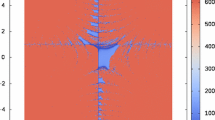Abstract
Modeling reaction kinetics in a homogeneous medium usually leads to stiff systems of ordinary differential equations the dimension of which can be large. The problem of determination of the minimal number of phase variables needed to describe the characteristic behavior of large scale systems is extensively addressed in current chemical kinetics literature from different point of views. Only for a few of these approaches there exists a mathematical justification. In this paper we describe and justify a procedure allowing to determine directly how many and which state variables are essential in a neighborhood of a given point of the extended phase space. This method exploits the wide range of characteristic time-scales in a chemical system and its mathematical justification is based on the theory of invariant manifolds. The procedure helps to get chemical insight into the intrinsic dynamics of a complex chemical process.
Similar content being viewed by others
References
A.C. Heard, M.J. Pilling and A.S. Tomlin, Mechanism reduction techniques applied to tropospheric chemistry, Atmos. Envir. 32 (1998) 1059–1073.
R. Lowe and A. Tomlin, Low-dimensional manifolds and reduced chemical models for troposcopic chemistry simulations, Atmos. Envir. 34 (2000) 2425–2436.
K.R. Schneider and T. Wilhelm, Model reduction by extended quasi-steady state approximation, J. Math. Biol. 40 (2000) 443–450.
L.A. Segel, On the validity of the steady state assumption of enzyme kinetics, Bull. Math. Biol. 50 (1988) 579–593.
L.A. Segel and M. Slemrod, The quasi-steady-state assumption: A case study in perturbation, SIAM Rev. 31 (1989) 446–477.
R. Heinrich and S. Schuster, The Regulation of Cellular Systems (Chapman and Hall, New York, 1996).
U.Maas, Automatische Reduktion von Reaktionsmechanismen zur Simulation reaktiver Strömungen, Institut für technische Verbrennung, Habilitation, Univ. Stuttgart (1993).
U. Maas and S.B. Pope, Simplifying chemical kinetics: intrinsic low-dimensional manifolds in composition space, J. Combust. Flame 88 (1992) 239–264.
D. Schmidt, T. Blasenbrey and U. Mass, Intrinsic low-dimensional manifolds of strained and unstrained flames, Combust. Theory Model. 2 (1998) 135–152.
R. Atkinson, A.C. Lloyd and L. Winges, An updated chemical mechanism for hydrocarbon /NOx/SO2 photooxidations suitable for inclusion in atmospheric simulation models, Atmos. Envir. 16 (1982) 1341–1355.
M.W. Gery, G.Z. Whitten, J.P. Killus and M.C. Dodge, A photochemical kinetics mechanism for urban and regional scale computer modeling, J. Geophys. Res. 94 (1989) 12,925–12,956.
T. Turányi, Sensitivity analysis of complex kinetic systems, Tools and applications, J. Math. Chem. 5 (1990) 203–248.
T. Turányi, Parameterisation of reaction mechanism using orthonormal polynomials, Comput. Chem. 18 (1994) 45–54.
N. Fenichel, Geometric singular perturbation theory for ordinary differential equations, J. Differential Equations 31 (1979) 53–98.
V.V. Strygin and V.A. Sobolev, Splitting of Motion by Means of Integral Manifolds (Nauka, Moscow, 1988) (in Russian).
P. Deuflhard and J. Heroth, Dynamic dimension reduction in ODE models, in: Scientific Computing in Chemical Engineering, ed. F. Keil (Springer-Verlag, Berlin, 1996) pp. 29–43.
P. Duchêne and P. Rouchon, Kinetic scheme reduction, attractive invariant manifold and slow/fast dynamical systems, Chem. Engrg. Sci. (submitted).
J.D. Murray, Mathematical Biology, Biomathematics, Vol. 19 (Springer-Verlag, Berlin, 1989).
R.J. Field, P.G. Hess, L.V. Kalachev and S. Madronich, Characterization of oscillation and a perioddoubling transition to chaos in a simple model of tropospheric chemistry, J. Geophys. Res. 106 (2001) 7553–7565.
L.V. Kalachev and R.J. Field, Absence of multiple steady states and a transition from steady state to monotonic growth behavior of [CO] and [O3] in a simple, nonlinear, oscillatory model of tropospheric photochemistry, Geophys. Res. Lett. 25 (1998) 2709–2715.
G.H. Golub and C.F. van Loan, Matrix Computations(Johns Hopkins University Press, Baltimore, 1989).
F. Brauer and J.A. Nohel, Qualitative Theory of Ordinary Differential Equations(Benjamin, New York, 1969).
K.R. Schneider, Relaxation oscillations in systems with different time-scales, in: Proc.Conf.Equadiff.VII Prague 1989, Teubner Texte Mathematik 118 (1991) 114–117.
K.R. Schneider, Relaxation oscillations and singularly perturbed autonomous differential systems, in: Proc.Int.Conf.Diff.Equs.Appl.Rousse 1989(1991) pp. 135–147.
P. Hess and S. Madronich, On tropospheric chemical oscillations, J. Geophys. Res. 102 (1997) 15,949–15,965.
M.C. Krol and D. Poppe, Nonlinear dynamics in atmospheric chemistry rate equations, J. Atmos. Chem. 29 (1998) 1–16.
R.W. Stewart, Dynamics of the low and high NOx transition in a simplified tropospheric photochemical model, J. Geophys. Res. 100 (1995) 8929–8943.
Author information
Authors and Affiliations
Rights and permissions
About this article
Cite this article
Handrock-Meyer, S., Kalachev, L. & Schneider, K. A Method to Determine the Dimension of Long-Time Dynamics in Multi-Scale Systems. Journal of Mathematical Chemistry 30, 133–160 (2001). https://doi.org/10.1023/A:1017960802671
Issue Date:
DOI: https://doi.org/10.1023/A:1017960802671



